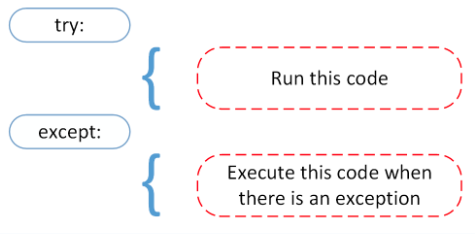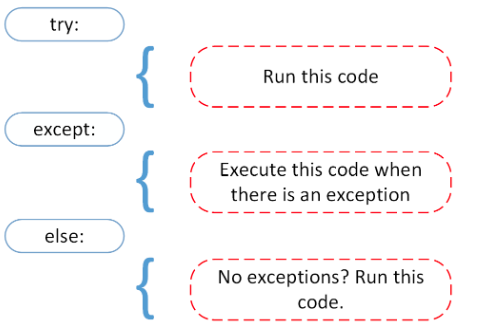Notes on FileIO & Exceptions
Read & Write Files in Python
Quotes and example code from this Real Python article
What is a file?
A file is typically composed of three parts:
- Header: metadata about file contents
- Data: file contents written by creators/editors
- End of file (EOF): indicated by special character
File Paths
…are strings that represent the location of a file, and are broken up into:
- Folder Path
- File Name
- Extension
Line Endings
“Windows uses the CR+LF characters to indicate a new line, while Unix and the newer Mac versions use just the LF character.” (\r\n on Windows or just \n on Mac)
Character Encodings
Encoding is the translation to human readable characters from byte data. Two most common are ASCII and UNICODE Formats: the former can only store 128 characters, while the latter can store up to 1,114,112 (ASCII is a subset of Unicode/UTF-8).
Opening and Closing a File in Python
The open built-in function:
file = open('file_name.txt')
It is my responsibility to close a file I have opened. There are two main ways.
First way is a try-finally block:
reader = open('dog_breeds.txt')
try:
# Further file processing goes here
finally:
reader.close()
Second way is using a with statement (IDEAL METHOD) which automatically closes file once it leaves with block, even when errors come up:
with open('dog_breeds.txt') as reader:
# Further file processing goes here
Other options for modes:
- ‘r’: open for reading (default)
- ‘w’: open for writing, truncating (overwriting) the file first
- ‘rb’ or ‘wb’: open in binary mode (read/write using byte data)
A file object is “an object exposing a file-oriented API (with methods such as read() or write()) to an underlying resource.” There are three types of file objects:
- Text files
- Buffered binary files
- Raw binary files
Text File Types
examples of how to open text files:
open('abc.txt')
open('abc.txt', 'r')
open('abc.txt', 'w')
A TextIOWrapper file object will be returned.
Buffered Binary File Types
examples of how to open them:
open('abc.txt', 'rb')
open('abc.txt', 'wb')
A BufferedReader or BufferedWriter file object will be returned.
Raw File Types
They are used as “low-level” building blocks, so not typical.
Reading and Writing Opened Files
Methods to call on file object to read file:
.read(size=-1): reads it based on number ofsizebytes (if size=0 or -1 or None is passed, entire file read).readline(size=-1): reads (at most) size # of characters from the line (if 0,-1, None – entire file read).readlines(): reads remaining file object lines and returns them as list items
Iterating Over Each Line In The File
Example with .readline():
with open('dog_breeds.txt', 'r') as reader:
line = reader.readline()
while line != '': # The EOF char is an empty string
print(line, end='')
line = reader.readline()
Example with .readlines():
with open('dog_breeds.txt', 'r') as reader:
for line in reader.readlines():
print(line, end='')
Or simply by iterating over file object itself (most Pythonic approach):
with open('dog_breeds.txt', 'r') as reader:
# Read and print the entire file line by line
for line in reader:
print(line, end='')
Methods for writing to a file:
.write(string): writes string to file.writelines(seq): writes the sequence to the file (no line endings are appender, so writer must add appropriate ones.)
Example of both:
with open('dog_breeds.txt', 'r') as reader:
# Note: readlines doesn't trim the line endings
dog_breeds = reader.readlines()
with open('dog_breeds_reversed.txt', 'w') as writer:
# Alternatively you could use
# writer.writelines(reversed(dog_breeds))
# Write the dog breeds to the file in reversed order
for breed in reversed(dog_breeds):
writer.write(breed)
The remainder of this article covers
- working with bytes
- a full example of reading and writing to a file
- more tips and tricks (including appending a file, working with two files at the same time, and creating your own context manager)
- reading and writing CSV files in Python
- working with JSON data in Python
Again, the link to this article.
Python Exceptions: An Introduction
Quotes and example code from this Real Python article
Exceptions vs Syntax Errors
Syntax errors occur when parser detects an incorrect statement (like one too many brackets).
Exception errors occur when syntactically correct Python code still launches an error.
Raising an Exception
We can use raise to throw an error/exception if a condition occurs (including a custom exception).
Example:
x = 10
if x > 5:
raise Exception('x should not exceed 5. The value of x was: {}'.format(x))
The AssertionError Exception
Make an assertion, if condition is True, great. If False, we can have program throw an AssertionError exception.
Example:
import sys
assert ('linux' in sys.platform), "This code runs on Linux only."
(may not be ideal, as program will come to halt and will not continue after AssertionError is thrown)
The try and except Block: Handling Exceptions

Using try-except block to improve on prior example:
def linux_interaction():
assert ('linux' in sys.platform), "Function can only run on Linux systems."
print('Doing something.')
try:
linux_interaction()
except:
pass
Error is handled by handing out a pass (which is good so program did not crash).
But ideally you want to see what kind of exception occured, so change pass to method to generate informative message like:
print('Linux function was not executed')
Example with AssertionError and output message displayed via try-except:
try:
linux_interaction()
except AssertionError as error:
print(error)
print('The linux_interaction() function was not executed')
Example of opening file and using built-in exception (if file.log does not exist, output will be
[Errno 2] No such file or directory: 'file.log'):
try:
with open('file.log') as file:
read_data = file.read()
except FileNotFoundError as fnf_error:
print(fnf_error)
Takeaways of this section:
- A try clause is executed up until the point where the first exception is encountered.
- Inside the except clause, or the exception handler, you determine how the program responds to the exception.
- You can anticipate multiple exceptions and differentiate how the program should respond to them.
- Avoid using bare except clauses.
The else Clause

An else statement tells a program to execute a certain block of code only when there were no exceptions.
You could output a message with something like:
print('Executing the else clause.')
Or run code in else clause to catch other possible exceptions. Example:
try:
linux_interaction()
except AssertionError as error:
print(error)
else:
try:
with open('file.log') as file:
read_data = file.read()
except FileNotFoundError as fnf_error:
print(fnf_error)
Cleaning Up After Using finally

A finally clause allows execution of an action to “clean up” (irrespective of any exceptions) after all other code in the above blocks have been executed.
Summary of article
raiseallows you to throw an exception at any time.assertenables you to verify if a certain condition is met and throw an exception if it isn’t.- In the try clause, all statements are executed until an exception is encountered.
exceptis used to catch and handle the exception(s) that are encountered in the try clause.elselets you code sections that should run only when no exceptions are encountered in the try clause.finallyenables you to execute sections of code that should always run, with or without any previously encountered exceptions.